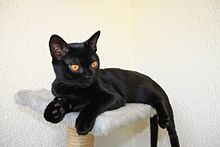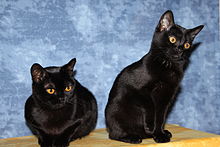| Bombay | |
|---|---|
 A common Bombay cat | |
| Common nicknames | Parlor Panther |
| Origin | United States |
| Breed standards | |
| CFA | standard |
| TICA | standard |
| ACF | standard |
| ACFA/CAA | standard |
| CCA-AFC | standard |
| Domestic cat (Felis catus) | |
The Bombay cat is a short-haired breed of domestic cat. Bombays are glossy solid black cats with a muscular build, and have characteristic large bright copper-golden eyes.[1][2][3] The breed is named after the Indian city of Bombay (Mumbai),[4] referring to the habitat of the Indian black leopard.[5]
There exist two different variants of Bombay breed; the American Bombay and the British Bombay. American-type Bombays were developed by crossbreeding sable American Burmese and black American Shorthair cats,[1][5] to produce a cat of mostly Burmese type, but with a sleek, panther-like black coat with copper-golden eyes. British-type Bombays are solid black-coloured Asian Self cats under the Asian group, a group of European Burmese and chinchilla Persian crosses.[1][6] The British-type Bombay originated from three mismatings of European Burmese with black domestic short-haired cats.[7]
Both type of Bombay cats are selectively bred by breeders and pedigreed in multiple major cat fancier and breeder organisations. Similar to other officially recognised cat breeds, the term "Bombay" is only meant to be used for cats from this specific breed, which are by definition all purebred cats with a known and formally registered ancestry, also known as the cat's pedigree or "paperwork".[8][9]
History[edit]
The breed was developed by Nikki Horner, a breeder from Louisville, Kentucky, who, starting in 1958, attempted to create a breed of cat that resembled a miniature black panther.[4][5][10] The first attempt was a failure, but the second, in 1965, was successful. The breed was officially recognised and registered by the Cat Fanciers' Association in 1970 and The International Cat Association in 1979.[4][10]
Appearance[edit]

The Bombay is described as the “patent leather kid with the new penny eyes.”[2][5] The Bombay is a short-haired breed of domestic cat, closely related to the Burmese. Bombay cats are characterised as having an all-black coat, including the whiskers, and black skin, including the soles, nose leather and mouth. The close-lying, sleek and glossy black coat is of mature cats is coloured to the roots with no paling (exceptions are allowed in juvenile cats less than 2 years old).[4] The eyes are always copper-golden coloured,[1][2] and green eyes are not allowed.[2][3]

The Bombay has a medium-sized, Oriental-type body build that is muscular.[1][4] Their weight ranges between 2.5–5 kg (5.5–11.0 lb),[1] with males typically being heavier than females.[3][11]
Breed standard[edit]
Body: Medium size, graceful and elongated Oriental-type body.[1] Elegant tail of medium length.[3]

Head: Rounded heads with no sharp angles, and short.[3] The shape is smooth. The muzzle is short, with a moderate nose “stop” which is visible (not a break).[2][3] The short-nosed head shape is similar to the American-type Burmese. The medium-sized ears are wide-set, straight, and rounded at the tips.
Eyes: The large, round eyes are set far apart[3] and are always copper-coloured,[2] but can range from bright orange to warm golden.[3] Green eyes are not allowed.[2][3]
Coat: Short, dense and shiny, tight to the body, with a lacquered sheen.[12] Only completely solid black coloured coats are allowed.[2][3]
Weight: For females, the average is 2.5–3.5 kg (6–8 lb). For males, the average is 3.5–5 kg (8–11 lb).[1][6]
Health[edit]
A healthy Bombay has an average lifespan of 15 years, and some have been known to live up to 20.[11] They can have some nasal and sinus problems, and gingivitis.[13] Their food intake should be controlled to avoid overfeeding.[13]
Temperament[edit]
The personality of the Bombay tends to be highly social, is marked by strong attachment to families, and is typified by craving attention. As a breed, they are therefore highly suitable for children.[14]
Bombay cats are happy and comfortable being strictly indoor cats, and can comfortably live in a single room apartment, so long as all of their needs are met.[15] They prefer quiet surroundings.[15]
References[edit]
- ^ a b c d e f g h Van Zyl, Miezan (2015). The cat encyclopedia - the definitive visual guide. London: Dorling Kindersley. ISBN 9780241234884. OCLC 1322361804.
- ^ a b c d e f g h "Bombay TICA breed standard" (PDF). Archived from the original (PDF) on 29 September 2023. Retrieved 29 September 2023.
- ^ a b c d e f g h i j "Bombay CFA breed standard" (PDF). CFA.org. Cat Fanciers' Association. 2019. Archived (PDF) from the original on 29 September 2023. Retrieved 29 September 2023.
- ^ a b c d e "Bombay". TICA.org. The International Cat Association (TICA). 13 August 2018. Archived from the original on 29 September 2023. Retrieved 29 September 2023.
- ^ a b c d "Bombay". CFA.org. Cat Fanciers' Association. Retrieved 29 September 2023.
- ^ a b Fogle, B.: The Encyclopedia of the Cat. Dorling Kindersley Limited: 2008
- ^ "Bombay and Asian Cats Breed Club". www.bombayandasiancatsbreedclub.org. Retrieved 29 September 2023.
- ^ "Finding the Purr-fect Pedigreed Kitten". CFA.org. The Cat Fanciers' Association. Retrieved 25 March 2024.
- ^ "What are Papers and Do I Need Them For My Pedigree Kitten?". Registered Pets. Retrieved 25 March 2024.
- ^ a b "History". Rokstarr Bombay. Retrieved 24 February 2016.
- ^ a b "Bombay Cat Breed Profile". pet-adoption-guide.com. Archived from the original on 16 February 2013. Retrieved 12 January 2013.
- ^ "How does Bombay look like?". bombaykittens.com. Retrieved 16 February 2023.
- ^ a b "Cat Breeds – The Bombay Cat – Cats, Chaos and Confusion". cats-chaos-and-confusion.com. Retrieved 4 January 2017.[permanent dead link]
- ^ "Bombay Cat". Petfinder. Retrieved 12 June 2011.
- ^ a b Adams, Charlene Tuttle (1995). Beauty of Cats. World Publications, Incorporated. ISBN 978-1-57215-086-7. Retrieved 5 April 2023.
External links[edit]
![]() Media related to Bombay cats at Wikimedia Commons
Media related to Bombay cats at Wikimedia Commons